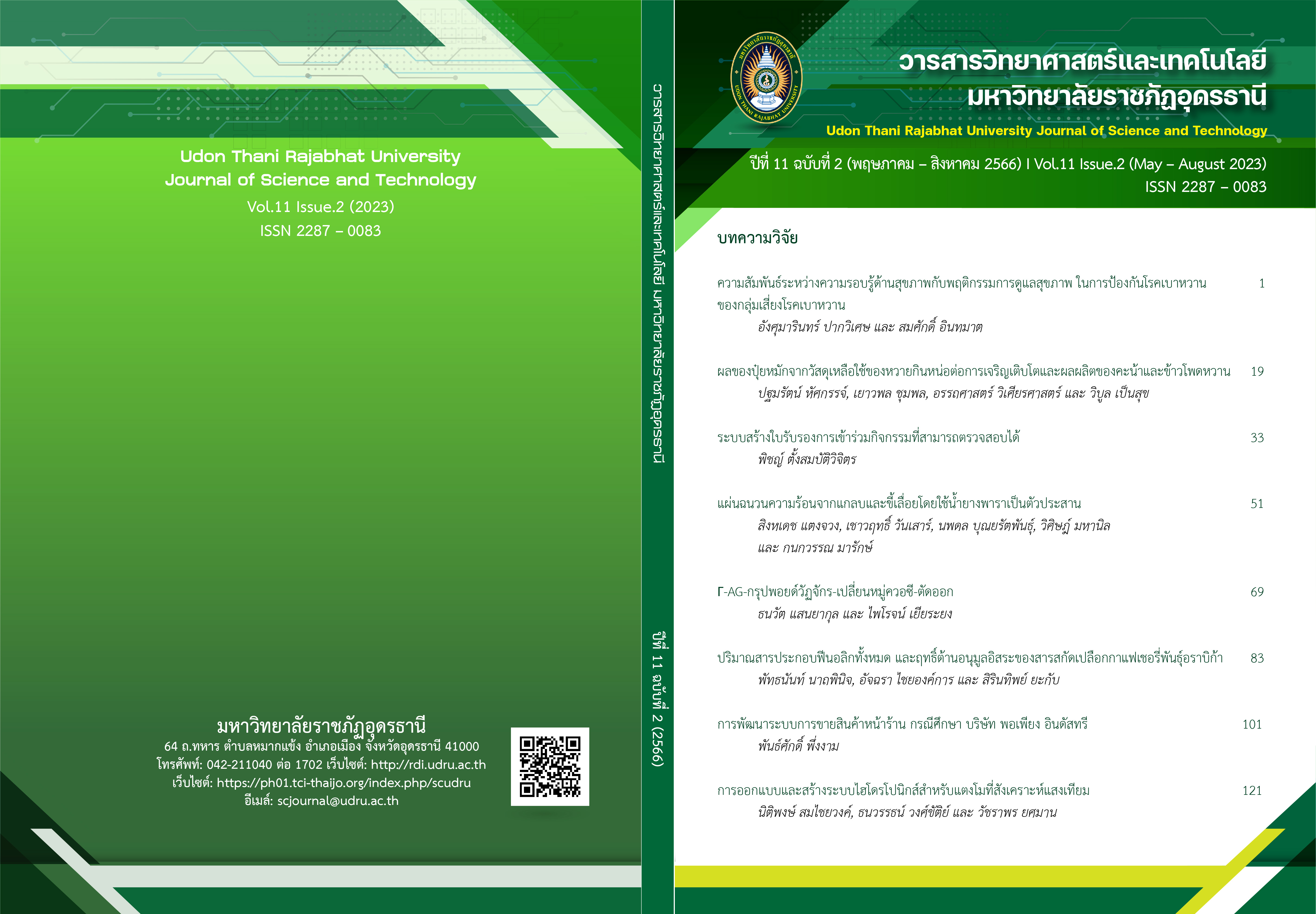EFFECTS OF COMPOST FROM RATTAN RESIDUES ON GROWTH AND YIELD OF CHINESE KALE AND SWEET CORN
Main Article Content
Abstract
The study of effects of compost from rattan residues on growth and yield of Chinese kale and sweet corn was carried out at Bantad Research and Development Center, Udonthani Rajabhat University. The objectives of this experimental were to compare effects of compost from rattan residues and chemical fertilizer on growth and yield of Chinese kale and sweet corn. Completely Randomized Design was used in this study. There were 3 treatments consisting of: Treatment 1, Chemical fertilizer, Treatment 2, Reduced 25 percentage of chemical fertilizer, adding 1,000 Kg/rai compost fertilizer and Treatment 3, Reduced 50 percentage of chemical fertilizer rate, adding 1,500 Kg/rai compost fertilizer. The plants were grown in plastic pots in a plastic greenhouse with 4 replications. The analysis of chemical properties of compost from rattan residual material were pH 7.5, electrical conductivity 5.56 dS/meter, organic matter 42 percent, organic carbon content 24.60 percent, carbon and nitrogen ratio (C/N ratio) 36.55, total nitrogen content 0.67 percent, total available phosphorus (P2O5) 0.85 percent, and total available potassium (K2O) 1.86 percent. The results of this study showed that adding compost with chemical fertilizer promoted the height and yield of Chinese kale significantly. However, adding 1,000 or 1,500 kg/rai of compost with reduced 25 or 50 percent rate of chemical fertilizer gave the same result. For sweet corn, all treatments did not show significant differences for height in an early growth stage but at 60 and 75 DAP, adding 1,500 kg/rai with 50 percent reduced rate of chemical fertilizer gave the highest plant height. All 3 treatments did not show the difference of the ear length, the ear width, the ear weight, number of seeds row per ear and brix index. Additionally, adding 1,000 or 1,500 kg/rai of compost with reduced 25 or 50 percent rate of chemical fertilizer showed the highest number of seeds/ear and the highest weight of seeds/ear while these two treatments did not show the significant differences.
Article Details
References
กรมวิชาการเกษตร. (2558). รายงานผลงานวิจัยและพัฒนาการผลิตหวายในพื้นที่ภาคตะวันออกเฉียงเหนือตอนบน. สืบค้นเมื่อวันที่ 21 มกราคม 2563, จาก https://www.doa.go.th/.
เกศศิรินทร์ แสงมณี, ธีระรัตน์ ชิณแสน, นัยวัฒน์ เกิดมงคล และ สมประสงค์ จันทรา. (2562). ผลของการใช้ปุ๋ยเคมีและปุ๋ยหมักจากขี้กรองอ้อยร่วมกับมูลสุกรต่อผลผลิตของอ้อยพันธุ์ขอนแก่น 3. วารสารเกษตรนเรศวร, 16(1), 9-14.
ฉลอง เกิดศรี และ ไพโรจน์ สุวรรณจินดา. (2551). การปลูกข้าวโพดหวานในสวนยางพารา. เกษตรชายแดนใต้ ฉบับชาวบ้าน, 3(8), 11.
ชัยสิทธิ์ ทองจู. (2538). การใช้อินทรีย์วัสดุเหลือใช้บางชนิดเป็นปุ๋ยไนโตรเจน สำหรับกวางตุ้งและข้าวโพดฝักอ่อนที่ปลูกในชุดดินกำแพงแสน. กรุงเทพฯ: มหาวิทยาลัยเกษตรศาสตร์.
ธีระพงศ์ จันทรนิยม และ อัจฉรา เพ็งหนู. (2557). การผลิตปุ๋ยหมักจากวัสดุเศษเหลือในโรงงานสกัดน้ำมันปาล์ม. เคหการเกษตร, 38(11), 234-240.
วรรณิศา ปัทมะภูษิต และ พรไพรินทร์ รุ่งเจริญทอง. (2557). ประสิทธิภาพปุ๋ยเคมีต่ออัตราการเจริญเติบโตและผลผลิตคะน้า. วารสารแก่นเกษตร, 42(3), 941-946.
วันยุภา บุตรวร, ณัฐรดา โสพิลา และ อังคณา เทียนกล่ำ. (2561). ผลของปุ๋ยเคมีและปุ๋ยหมักเติมอากาศต่อการเจริญเติบโตและผลผลิตของหอมแบ่ง. วารสารวิชาการสถาบันการอาชีวศึกษาเกษตร, 2(2), 40-46.
ศิราณี วงศ์กระจ่าง. (2558). ผลของการใช้ปุ๋ยหมักจากทะลายเปล่าปาล์มน้ำมันและปุ๋ยน้ำหมักต่อการเจริญเติบโตพืช. วารสารวิทยาลัยราชนครินทร์, 7(1), 146-152.
ศุภมาศ พนิชศักดิ์พัฒนา, กุลวดี คันธวิวรณ์ และ สุเทพ ทองแพ. (2531). การใช้วัสดุเหลือใช้บางชนิดเป็นปุ๋ยพืชไร่ในชุดดินกำแพงแสน มหาวิทยาลัยเกษตรศาสตร์ คณะเกษตร กรุงเทพฯ. สืบค้นเมื่อวันที่ 23 เมษายน 2562, จาก http://www.pikul.lib.ku.ac.thcgi-binagre.exe?recid=005203&database=agre&search_type=link&table=mona&back_path=agremona&lang=thai&format_name=TFMON.
สมถวิล รุ่งศิรินันท์พร. (2545). ผลของปุ๋ยหมักฟางข้าวชนิดต่าง ๆ ที่มีต่อผลผลิตของผัก. คณะวิทยาศาสตร์และเทคโนโลยี สถาบันราชภัฏเลย จังหวัดเลย. สืบค้นเมื่อวันที่ 19 พฤษภาคม 2562, จาก http://www.pikul.lib .ku.ac.th/cgi-bin/agre.exe?rec_id=004073&database=agre&search_type=link&table=mona&back_path=/agre/mona&lang=thai&format_name=TFMON.
สำนักงานสถิติจังหวัดสกลนคร. (2561). รายงานวิเคราะห์สถานการณ์จังหวัดสกลนคร. สืบค้นเมื่อวันที่ 5 มีนาคม 2563, จาก http://www.osthailand.nic.go.th/ masterplan_area/userfiles/file%20.
อมลณัฐ ฉัตรตระกูล. (2554). รายงานวิจัยฉบับสมบูรณ์ เรื่อง การพัฒนาผลิตภัณฑ์ปุ๋ยหมักจากวัสดุเหลือใช้ของมะขาม. เพชรบูรณ์: มหาวิทยาลัยราชภัฏเพชรบูรณ์.
อุไรวรรณ ไอยสุวรรณ์. (2556). ผลของการใช้ปุ๋ยหมักร่วมกับปุ๋ยเคมีไนโตรเจนที่มีต่อผลผลิตและประสิทธิภาพการใช้ธาตุไนโตรเจนของข้าว. วารสารวิชาการเกษตร, 31(3), 270-281.
He, Z., Yang, X., Kahn, B. A., Stoffella, P. J., & Calvert, D. V. (2001). Plant nutrition benefits of phosphorus, potassium, calcium. Magnesium, and micronutrients from compost utilization. In Compost Utilization in Agricultural Cropping Systems. New York: Lewis.
Richard, T. L. (1992). Municipal solid waste composting. Physical and biological processing. Biomass & Bioenergy, 3(3-4), 195-211.


